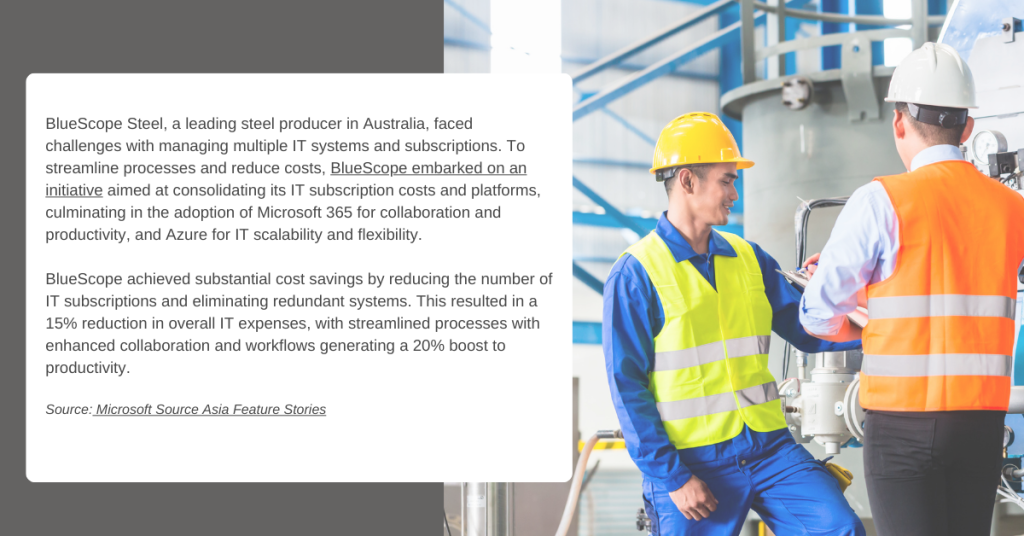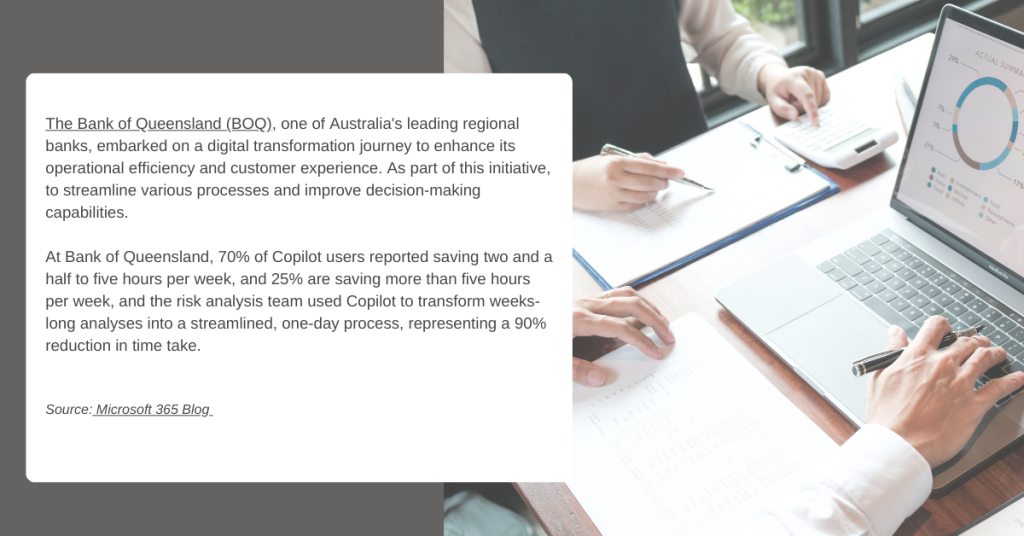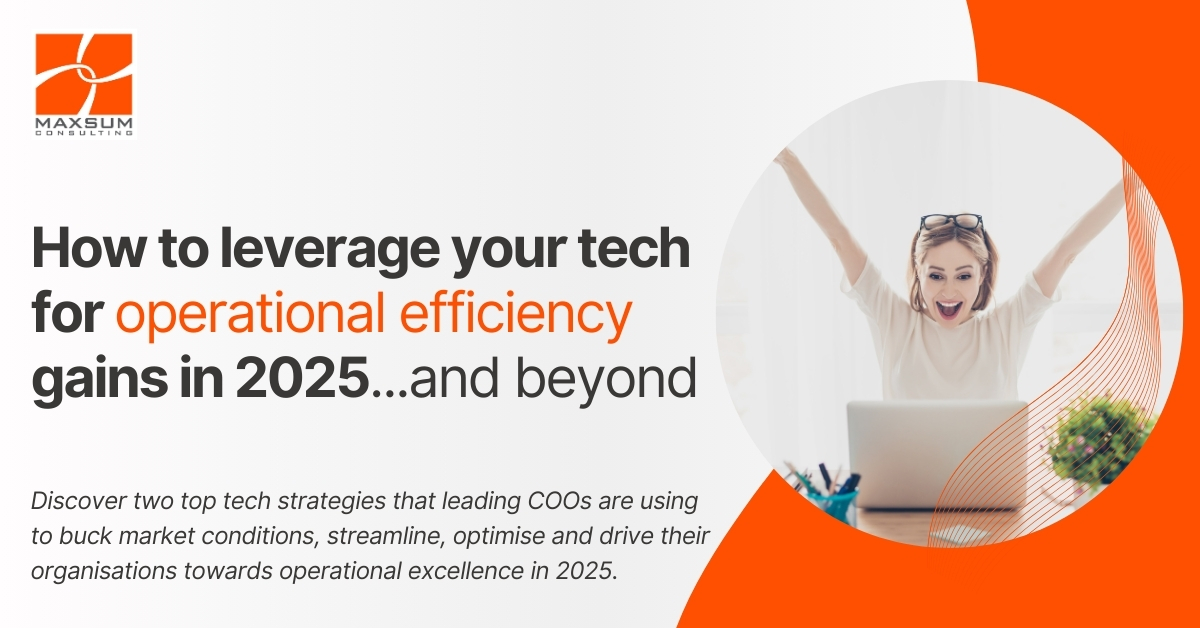What sets market-leading companies apart from the rest right now? It’s their pursuit of operational efficiency by leveraging all that technology has to offer. Discover two top tech strategies that leading COOs are using to buck market conditions, streamline, optimise and drive their organisations towards operational excellence in 2025.
What’s happening in Australian right now?
If you’ve entered 2025 feeling a sense of unease about how you’re going to drive efficiency gains and hit your targets given current market conditions, you’re not alone!
Many directors and business leaders are feeling the same, according to the AICD’s most recent Director Sentiment Index Report for the 2nd half of 2024. Giving a direct insight into the flagging business and economic sentiment right now, the top challenges cited by Australian business execs heading into 2025 remain telling:
- Rising costs and inflation pressures
- Productivity growth
- Skills and labour shortages
Whilst fully expecting their costs to continue to increase, many are anticipating an accompanying fall in profitability if they cannot realise the efficiency gains needed to drive the productivity growth that 1 in 3 execs ranked their number 1 issue.
What does this mean for Australian businesses?
As the end of FY2025 casts a somewhat bleak economic shadow on the horizon, operations leads will be honing in on specific ways to boost operational efficiency. They’ll need to prioritise strategies aimed at streamlining operations, enhancing customer experience and driving growth, all the while keeping a keen eye on the bottom line, market conditions, as well as their cyber and business risk exposure.
It’s a complex balancing act for sure, and although you’re likely full aware that the business technology systems, services and processes you use to drive operations are key, right now, operations leads must be more focused on how they can better implement, refine, adopt and leverage business technology to accelerate business efficiency.
How technology can accelerate operational efficiency
This is not a case of “out with the old and in with the new”. Many Australian companies have already made substantial investments in digital transformation over recent years, especially post-pandemic as they moved to better managed, more secure digital tools to facilitate hybrid work. Now is the time for operations leaders to extract more value from those investments by looking into what else digital tools can do.
Business technology is at a critical inflection point right now with the leading providers in a race to the future, as they continue to amp-up integrations, automation and AI technologies across their apps and services. Business leaders right now can leverage all this shuffling, repackaging of their existing technology products and services to their advantage – if they know what they are! Understanding the inclusions you may now have access to will show how can you do more with what you’ve got. Then strategically “turning on” and embedding value-adding processes and features will save time, money and resources.
And in terms of “the new”, proactively embracing new automation and Generative AI toolsets, like Microsoft 365 Copilot, level up your ability to do more with less. Cut down the time your people spend on repetitive tasks so they can focus on higher value tasks. Speed up people’s access to data and information to accelerate output and completion rates. Then get immediate insights so you can pivot fast if needed, or make more accurate plans and decisions.
Strategy 1: Do more with what you’ve got – Unpack what’s hidden in your tech stack
Why do it?
Here’s an unsettling fact – your organisation is likely only utilising a fraction of the features, apps and services available to you through any of your technology license or subscriptions.
Varying reports and surveys clock the underutilisation of subscription apps and services in businesses in the range of 20-50%, while Microsoft economic impact reports found that many organisations only use about 20% of the features available to them in their Microsoft 365 subscriptions.
Inflationary climate or otherwise, there’s simple no reason not to find ways to make use of what you’re paying for already to the fullest extent possible. You’ll also likely find subscriptions to other third-party services that provide features that are also available in another service you already pay for. Combine underutilisation with double-ups and you’ve effectively doubled your costs, as well as your maintenance overhead and cyber risk.
- What’s hiding in your technology stack that you could be deriving immediate value from?
- What’s apps and services are you effectively paying twice for, because you’ve got another third-party subscription that does effectively the same thing?
- When’s the last time you actually took stock of which products, apps and services are being used across your organisation or department?
- What’s new in your core apps and services that might replace a third-party service?
How will this drive operational efficiency
Maximising utilisation of other high-value apps and services in your existing stack, and minimising the spread of information, data and work across disparate toolsets will:
- Eliminate double-ups and redundancies in products, services and features
- Cut down on unnecessary subscription costs and save you money
- Streamline your supply chain management and support requirements
- Centralise and de-silo important data and information that may have been collected, held, access or processed across different services
- Gives your team easier access and visibility to the information they need
- Tightens up your ability to manage and control your security and privacy provisions at scale
- Consolidates your data and information in one ecosystem, ready and waiting for automation and knowledge creation with Generative AI.
How to get it done
Taking stock of how well you’re utilising what you’re already investing in is a great place to start.
- Review expenses: Review your expenses, subscriptions, purchases, and service agreements to identify cost-saving, cost consolidation opportunities and identify under-utilised inclusions in subscriptions and licenses.
- Extract more value from providers: Engage with providers, explore bundling in access to additional products and services instead of doubling up, and lean on them for training and advice on what’s news as well as ways to improve technology utilisation across your organisation.
- Make more intentional decisions: Implement review and approval processes that include looking at options you may already have access to first or prioritising provider partnerships for solutions that work with or extend what you already have.

Strategy 2: Do more with less – Introduce and embrace AI and Automation
Why do it?
As a small or medium-sized business (SMB) leader, you’ve likely heard a lot about generative AI and how it’s transforming businesses of all sizes. Embracing automation and artificial intelligence (AI) can significantly accelerate operational efficiencies within your organisation – and the time is now. Investing in automation and AI is not just about jumping on the bandwagon; it’s about transforming your operations to achieve sustainable growth and success. This is where our business futures are all heading.
It is acknowledged that SMBs, for example, are only half as productive as large companies. Employees at small and medium-sized businesses often juggle multiple roles and get pulled into various tasks across various departments, which can leave them with less time for their own projects. Emerging Generative AI tools can help address this challenge by taking over routine, repetitive tasks, allowing people to move on to more strategic, higher value work.
AI-powered platforms can manage interactions between team members, automate workflows, and enhance productivity through features like meeting transcription services, email inbox organisation, and content creation assistance. AI-powered analytics deliver immediately follow-ups and insights, facilitating faster, highly contextual decision-making, especially on how to optimise end-to-end processes and workflows across the board.
How will this drive operational efficiency
Many organisations are already leveraging the transformational impact of Generative AI and automating repetitive and time-consuming tasks to:
- Free up valuable human resources to focus on strategic initiatives and innovation
- Shift resources toward growth-focused initiatives without overwhelming your team.
- Reduce errors and operational costs
- Enhances productivity and agility
- Improve customer satisfaction through faster access to information and faster response times
- Build a more resilient and competitive business.
How to get it done
- Identify use cases: Assess your business processes to identify areas where ai, automation, or data technology could have a significant impact.
- Explore options: Start by looking at what AI, automation or analytics features are included or available with your current operational tools and platforms to supercharge what you already have without adding security or privacy risk or overhead.
- Train & empower employees: Really highlight what new tools and features will deliver to your team. Train your team continuously on new ways they can do more with the tools and empower them to collaborate and share knowledge to find new ways your team can work.

- In this article, we’ve focus on technology strategies to accelerate operational efficiency – how to leverage technology to do more, more efficiently.
- Next up, we will focus on technology strategies to amplify the impact operational efficiency gains – how to leverage technology to deliver more to your people and customers.
Need advice on how to get this done?
The team at Maxsum can guide you through exactly how to apply these strategies in your business to deliver immediate efficiency gains. Let’s have a chat about how to boost technology utilisation and embrace AI and automation in 2025.



